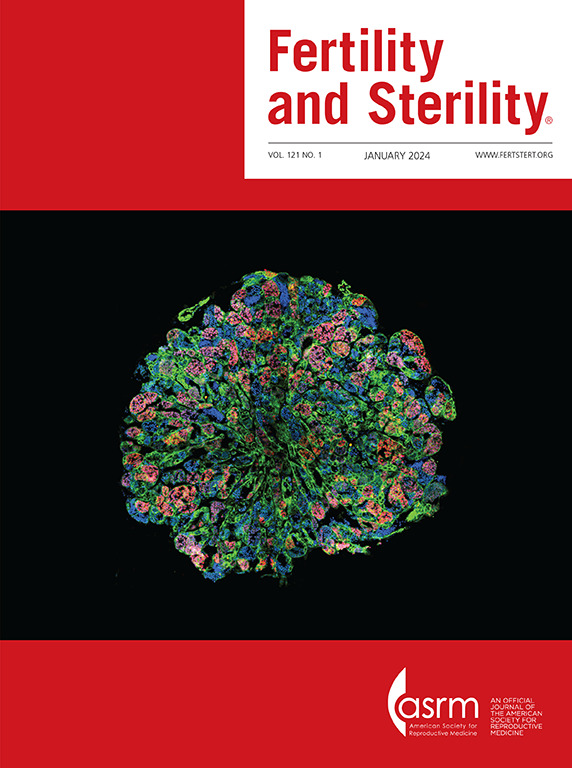寻求生育能力评估的男性家庭成员的死亡风险。
IF 6.6
1区 医学
Q1 OBSTETRICS & GYNECOLOGY
引用次数: 0
摘要
目的评估寻求生育能力评估的男性家庭成员的死亡率。低生育能力是整体躯体健康的生物标志物,而精液质量差与慢性疾病住院和死亡风险增加有关。然而,目前尚不清楚这些风险是否会延伸到精子数量低的男性的家庭成员。设计回顾性队列研究。作为1996-2017年生育能力评估的一部分,接受精液分析的低生育能力、健康和辅助生殖与环境队列男性的家庭成员,直至三级亲属。1904-2017年在犹他州居住≥1年且记录精子总数的男性亲属被纳入分析(N=11,355个家庭)。暴露个体按家庭成员进行分类。家族分为无精子(0M)、少精子(<39M)和正常精子(≥39M)男性亲属。先证者(男性亲属)的平均总精子数与生育能力评估也被纳入连续暴露测量。主要结局指标:主要结局是按性别、年龄和相关程度划分的全因和特定原因死亡风险:一、二、三度。采用Cox比例风险模型检验生育分类与控制性别和出生年份的死亡率之间的关系。结果共纳入666,437例男性生育能力评估亲属(Ndeaths=183,974例)。与正常精子症家族相比,少精症家族的全因死亡风险增加(holigozospermia =1.03 95%CI=1.01-1.05)。近亲属,一级(HRoligozoospermia=1.17 95%CI=1.07-1.28)和二级亲属(HRazoospermia=1.11 95%CI=1.04-1.20;无精子症和少精子症患者(95%CI=1.01-1.09)的全因和病因特异性死亡风险最高,包括因心血管疾病、先天性出生条件导致的死亡。结论家族性全因死亡风险和因特异性死亡风险因生育表型而异。无精子和少精子男性家庭的风险显著增加,尤其是近亲。这项研究提供了进一步的证据,共同的遗传和/或环境因素可能影响生育和躯体健康。本文章由计算机程序翻译,如有差异,请以英文原文为准。
Risk of Mortality in Family Members of Men Seeking Fertility Assessment.
OBJECTIVE
To assess mortality in family members of men seeking fertility assessment. Subfertility serves as a biomarker for overall somatic health and poor semen quality is associated with increased risk of hospitalization and mortality from chronic conditions. However, it is unclear if these risks extend to family members of men with low sperm count.
DESIGN
Retrospective cohort study.
SUBJECTS
Family members, out to third-degree relatives, of men in the Subfertility, Health and Assisted Reproduction and the Environment cohort who underwent a semen analysis as part of a fertility assessment 1996-2017. Relatives of men with a recorded total sperm count who lived in Utah for ≥1 year 1904-2017 were included in the analysis (N=11,355 families).
EXPOSURE
Individuals were classified by family membership. Families were classified as relatives of azoospermic (0M), oligozoospermic (<39M), or normozoospermic (≥39M) men. Average total sperm count of the proband (male relative) with fertility assessment was also included as a continuous exposure measure.
MAIN OUTCOME MEASURES
The main outcomes were all-cause and cause-specific mortality risk by sex, age, and degree of relation: first-, second-, and third-degree. Cox proportional hazard models were used to test the association between fertility classification and mortality controlling for sex and birth year.
RESULTS
A total of 666,437 relatives of men with fertility assessment (Ndeaths=183,974) were included in the analysis. Relative to normozoospermia families, all-cause mortality risk increased in oligozoospermia families (HRoligozoospermia=1.03 95%CI=1.01-1.05). Close relatives, first- (HRoligozoospermia=1.17 95%CI=1.07-1.28) and second-degree relatives (HRazoospermia=1.11 95%CI=1.04-1.20; HRoligozoospermia=1.05 95%CI=1.01-1.09), of azoospermic and oligozoospermic men had the highest all-cause and cause-specific mortality risk, including death due to cardiovascular disease, congenital birth conditions.
CONCLUSION
Our results suggest that familial all-cause and cause-specific mortality risk differs by fertility phenotype. Families of azoospermic and oligozoospermic men showed significantly increased risk, particularly for close relatives. This study provides further evidence that shared genetic and/or environmental factors could influence both fertility and somatic health.
求助全文
通过发布文献求助,成功后即可免费获取论文全文。
去求助
来源期刊

Fertility and sterility
医学-妇产科学
CiteScore
11.30
自引率
6.00%
发文量
1446
审稿时长
31 days
期刊介绍:
Fertility and Sterility® is an international journal for obstetricians, gynecologists, reproductive endocrinologists, urologists, basic scientists and others who treat and investigate problems of infertility and human reproductive disorders. The journal publishes juried original scientific articles in clinical and laboratory research relevant to reproductive endocrinology, urology, andrology, physiology, immunology, genetics, contraception, and menopause. Fertility and Sterility® encourages and supports meaningful basic and clinical research, and facilitates and promotes excellence in professional education, in the field of reproductive medicine.
 求助内容:
求助内容: 应助结果提醒方式:
应助结果提醒方式:


